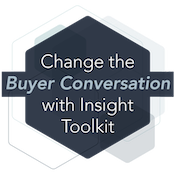In What Sales Winners Do Differently, we studied over 700 purchases from the perspective of business-to-business buyers to find out what really happened in their buying experiences.
In our research, we looked at the factors that most separate sales winners from second-place finishers. These are the essential selling skills you need to find yourself in the winner's circle.
In the infographic, we share what you need to do to master each of these essential selling skills and boost your sales success. Below, you’ll find some additional ideas for how each selling skill can improve your performance

The 10 Essential Selling Skills
-
1. Educate
Sales winners educate buyers with new ideas and perspectives 2.9X more often than second-place finishers.
This doesn’t mean a seller is lecturing or talking at a buyer. Instead, the seller is asking incisive questions, learning about the buyer’s world, and helping them see what’s possible.
We call this insight selling—the process of creating and winning sales opportunities, and driving change, with ideas that matter. There are two ways you can apply insight selling in your conversations.
- Opportunity insight: Sharing a particular idea or strategy a buyer should pursue but might not know about.
- Interaction insight: Providing value in the form of creating insights through buyer and seller conversation.
Buyers are more informed than ever, but this also means they expect more from sellers. By providing new ideas and perspectives, top sellers become the value that buyers are looking for, and buyers seek them out.
Learn more in our toolkit, How to Change the Buyer Conversation with Insight. You'll get the frameworks and tools you need to lead more impactful sales conversations and sell with insight. Download it now. >>
2. Collaborate
Top Performers rate their processes to work collaboratively with accounts to co-create value much higher than The Rest. In fact, the best sellers are 2.7x more effective at collaborating with buyers.
Today it’s more important than ever for sellers to have strong collaboration skills. The increased prevalence of virtual selling means you need to find innovative ways to engage and collaborate with buyers. Done well, virtual collaboration can be even more effective than in-person. Done poorly, it can lead to buyer disengagement.
The first step is to go into conversations with a good grasp on technology. Technical issues are distracting and hinder meaningful communication.
You also need to know the virtual collaboration tools that will add the most value to your interactions with buyers. Virtual whiteboards, multimedia, interactive presentations, and more can all be used in tandem to keep buyers engaged in the conversation.
Read: 3 Ways to Enable Collaboration—Even in a Virtual Meeting
3. Persuade
Sales winners are much more likely to persuade buyers they’ll achieve results. Often, this means making a financial case for why an investment is worth it.
Before you share your ROI case, you’ll need to do your research. Buyers hear pitches all the time, and you’ll need to make sure yours is customized, in-depth, and believable to stand out from the crowd.
However, making the ROI case alone isn’t sufficient. Yes, communicate the rational case, but don’t neglect the emotional case for change. Communicate the impact of the solution on the buyer’s aspirations and afflictions and you’ll be in a strong position to influence the buyer’s agenda.
4. Listen
While it pays to be proactive in your conversations with buyers, don’t steamroll them. Take time to listen. According to our research, this is one of the top factors most separating sales winners from those coming in second place.
Make your conversations valuable—both for yourself and the buyer. Ask questions that demonstrate your understanding, and actively listen to the responses. Don’t be afraid to change course based on what the buyer is saying.
Know when to talk about your offerings and when to pull back and let buyers tell their stories. When they do, there’s a good chance you’ll learn something valuable.
5. Understand needs
Buyers want sellers who "get it." To develop an understanding of your buyer, ask powerful questions.
Open-ended questions can help you uncover latent needs and find value a buyer may not have previously considered. For example, “What does success look like for this project?” The question doesn’t need to be complex; it just needs to be well-suited for the conversation and get your buyer thinking differently about what you can offer.
Closed-ended questions can help you diagnose a situation and rule out specific approaches or solutions, for example, “Should your team be doing more of X?” Then, use follow-up questions to get the buyer to continue elaborating on a problem or issue. For example, “Why?” or, “Can you tell me more?”
Don’t interrogate the buyer, but do use questions skillfully. You’ll uncover valuable information and a better understanding of their needs.
6. Minimize risk
Any purchase carries a certain amount of risk. Because of this, buyers want sellers to help them avoid potential pitfalls. Good sellers are proactive about mitigating risk, highlighting potential risks, and reducing impact however they can.
Contrary to what you might think, bringing up risk can be positive in sales conversations. If you can demonstrate you’re able to reduce risk for a buyer, you establish yourself as a credible and trustworthy seller.
Read: 5 Changes in B2B Buying Behavior You Need to Know About
7. Craft compelling solutions
Buyers report that 7 out of 10 sales winners craft compelling solutions. Remember, you’re trying to help buyers meet their goals, and if you’re out of touch with their needs, your solutions won’t motivate them to close a sale.
The best way to create a compelling solution is to communicate impact.
Ask yourself—what happens if a buyer’s aspirations aren’t achieved? What happens if their afflictions go unanswered? Emphasizing the value of an investment in these terms can be critical to persuading a seller to prioritize your offerings.
8. Build trust
Sales winners set and meet expectations to build trust with buyers. They also depict the purchasing process accurately.
In the sales world, a certain amount of skepticism is natural for buyers. Establishing trust helps get you that second call and differentiate you from competitors.
You can start building trust by demonstrating your capability. One way to do this by being an expert. We’ve already mentioned how modern sellers need to provide value to their buyers, and a thorough knowledge of the buyer's industry, business, competition, and problems is necessary to do so.
9. Build relationships
Strong relationships close sales. Sixty-two percent of sales winners connect with buyers personally compared to only 45% of second-place finishers.
Too often, small talk during sales conversations can feel contrived and superficial. Establishing a genuine connection starts with empathy. Empathic sellers are:
- Aware of what’s going on here and now, rather than thinking of what they’re going to say next
- In-tune with the buyer's verbal and non-verbal cues
- Capable of discussing buyers’ goals and challenges without pitching
- Consistent about following up
- Mindful of the difference between empathy and sympathy
10. Differentiate based on value
Top-performing sellers provide maximum value compared to competitors. Maximum value doesn’t necessarily mean the lowest price compared to competitors. Rather, it reflects the expertise and insight the seller can provide.
We’ve also found that value-driving sales organizations are more likely to grow revenue and have higher win rates on proposed sales.
Download the research report: The Value-Driving Difference
What’s the difference? Value-driving sellers and sales organizations excel at proactively discovering and discussing needs with buyers. Many of the factors we’ve already discussed (collaboration, education, and minimizing risks, to name a few!) are all part of value-building.






